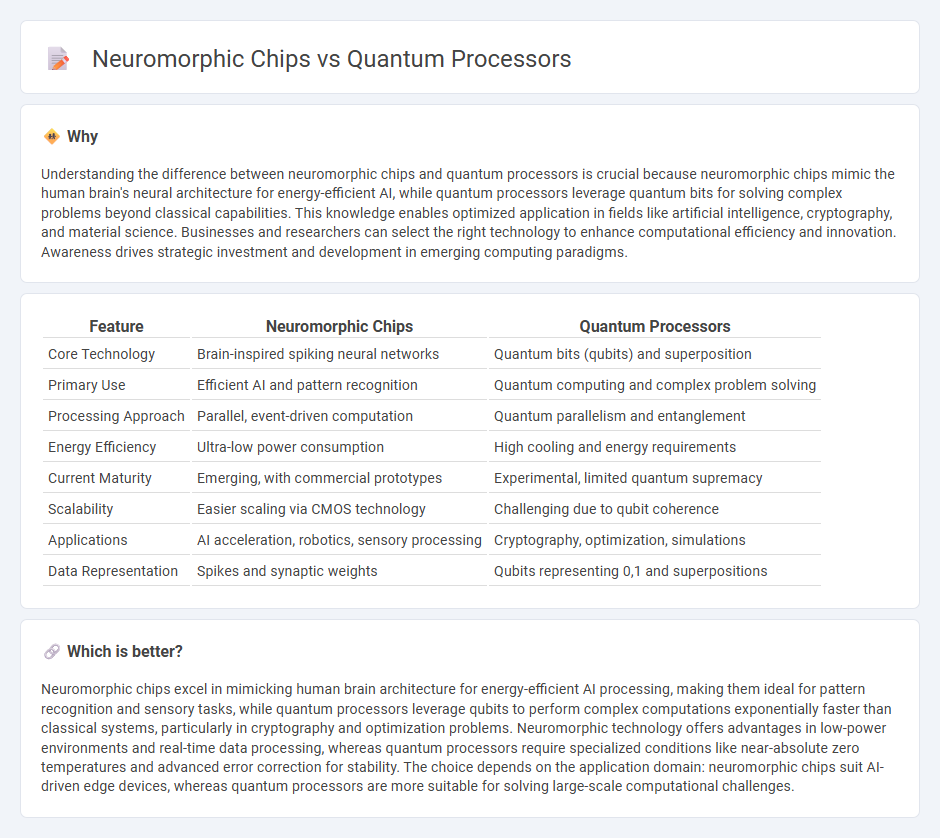
Neuromorphic chips mimic the structure and functioning of the human brain using artificial neurons and synapses to process information efficiently in tasks like pattern recognition and sensory processing. Quantum processors harness quantum bits (qubits) to perform complex computations far beyond classical computers, leveraging principles like superposition and entanglement for applications in cryptography and optimization. Explore the intricacies and future potential of these groundbreaking technologies to understand their transformative impact on computing.
Why it is important
Understanding the difference between neuromorphic chips and quantum processors is crucial because neuromorphic chips mimic the human brain's neural architecture for energy-efficient AI, while quantum processors leverage quantum bits for solving complex problems beyond classical capabilities. This knowledge enables optimized application in fields like artificial intelligence, cryptography, and material science. Businesses and researchers can select the right technology to enhance computational efficiency and innovation. Awareness drives strategic investment and development in emerging computing paradigms.
Comparison Table
| Feature | Neuromorphic Chips | Quantum Processors |
|---|---|---|
| Core Technology | Brain-inspired spiking neural networks | Quantum bits (qubits) and superposition |
| Primary Use | Efficient AI and pattern recognition | Quantum computing and complex problem solving |
| Processing Approach | Parallel, event-driven computation | Quantum parallelism and entanglement |
| Energy Efficiency | Ultra-low power consumption | High cooling and energy requirements |
| Current Maturity | Emerging, with commercial prototypes | Experimental, limited quantum supremacy |
| Scalability | Easier scaling via CMOS technology | Challenging due to qubit coherence |
| Applications | AI acceleration, robotics, sensory processing | Cryptography, optimization, simulations |
| Data Representation | Spikes and synaptic weights | Qubits representing 0,1 and superpositions |
Which is better?
Neuromorphic chips excel in mimicking human brain architecture for energy-efficient AI processing, making them ideal for pattern recognition and sensory tasks, while quantum processors leverage qubits to perform complex computations exponentially faster than classical systems, particularly in cryptography and optimization problems. Neuromorphic technology offers advantages in low-power environments and real-time data processing, whereas quantum processors require specialized conditions like near-absolute zero temperatures and advanced error correction for stability. The choice depends on the application domain: neuromorphic chips suit AI-driven edge devices, whereas quantum processors are more suitable for solving large-scale computational challenges.
Connection
Neuromorphic chips and quantum processors both represent breakthrough technologies designed to mimic aspects of human cognitive processes, enhancing computational efficiency and problem-solving capabilities. Neuromorphic chips emulate neural architectures to process information in parallel with low energy consumption, while quantum processors leverage quantum bits (qubits) enabling complex calculations through superposition and entanglement. Integrating neuromorphic principles with quantum computing aims to create hybrid systems capable of advanced learning and optimization tasks beyond classical and purely quantum approaches.
Key Terms
Qubit
Quantum processors leverage qubits that exist in superposition and entanglement, enabling simultaneous processing of vast computational states, unlike neuromorphic chips that mimic neural architectures for brain-inspired computation without quantum effects. Qubits offer exponential scalability for complex problem-solving in cryptography and optimization, whereas neuromorphic chips excel in energy-efficient pattern recognition and real-time sensory data processing. Explore the unique capabilities and future potential of qubit-based quantum processors versus neuromorphic computing by diving deeper into their architectures and use cases.
Spiking Neural Network
Quantum processors leverage qubits to perform complex calculations through superposition and entanglement, offering exponential speedups for certain algorithms. Neuromorphic chips simulate Spiking Neural Networks (SNNs), mimicking the brain's event-driven architecture to achieve energy-efficient, real-time processing suitable for sensory and cognitive tasks. Explore more about how Spiking Neural Networks impact the future of AI hardware.
Superposition
Quantum processors leverage superposition to enable qubits to represent multiple states simultaneously, vastly increasing computational parallelism and efficiency in solving complex problems. Neuromorphic chips mimic neural architectures but do not inherently utilize superposition; instead, they focus on parallel processing inspired by the brain's synaptic connectivity to enhance learning and adaptability. Explore how superposition fundamentally distinguishes quantum computing performance and potential from neuromorphic approaches.
Source and External Links
What Is a Quantum Computer Processor & How It Works - SpinQ - A quantum processor uses qubits that exist in superposition and entanglement, enabling parallel processing and complex computations far beyond classical processors.
What is a QPU (Quantum Processing Unit)? - IBM - IBM's Quantum Processing Unit (QPU) utilizes superconducting qubits to process data as 0, 1, or both simultaneously, with entanglement allowing instant correlation between qubits for advanced algorithm execution.
Microsoft unveils Majorana 1, the world's first quantum processor powered by topological qubits - Majorana 1 is the first quantum processor built with topological qubits, designed for massive scalability and higher reliability through hardware-protected quantum error correction.
 dowidth.com
dowidth.com